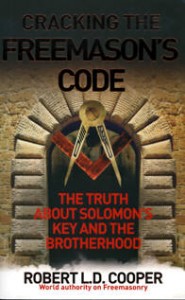Cracking the Freemason’s Code
By Robert L. D. Cooper
Paperback. 240 pages. ISBN: 9781846040498. £9.99
 The author is probably best known for his recently published book: The Rosslyn Hoax? and that has almost completely overshadowed this book which, although dealing with Freemasonry, does so in a completely different way.
The author is probably best known for his recently published book: The Rosslyn Hoax? and that has almost completely overshadowed this book which, although dealing with Freemasonry, does so in a completely different way.
For a start this book is not as academic as The Rosslyn Hoax? and is written in the first person. This means that the book ‘speaks’ to the reader in a way that The Rosslyn Hoax? does not. Yet both books discuss the some of the same subjects – the principal one being, of course, Freemasonry. The author’s historical approach is obvious and he says as much in the introduction but he explains Freemasonry in a way that makes the subject, and especially its origins, easily understandable. The content is firmly from a Scottish perspective and is quite different from the common view that modern Freemasonry began with the founding of the Grand Lodge of England in 1717. The author goes much further back than that and cites documents and other source material that convincingly shows that modern Freemasonry began in Scotland during the later 1500’s developing from Scottish stonemasons’ Lodges. His section on early ritual is fascinating and he reproduces the earliest known ritual leaving little room for doubt as to the Scottish origins of the Craft. He explores the alleged connection between Freemasonry and Rosslyn Chapel, the Knights Templar etc. The documents used in this respect are frequently cited by popular authors but this book confirms that many simply do not understand what the documents mean. His brief investigation into possible Hermetic influences and how they may have come to be part of Freemasonry is most important and perhaps could have been explained in more and better detail.
Whilst it is obviously a book directed at the public in an effort to explain what Freemasonry is, its ethos and origins, the author also reveals some very intriguing information. The chapter on the Free Gardeners is an example. Free Gardenery was very similar to Freemasonry with Lodges, degrees (three of them), aprons and symbolism and was an ‘organisation’ which grew to be larger that Freemasonry certainly in terms of number of members and Lodges. The author’s description and discussion of this other ‘secret society’ is fascinating but he does not stop there – who is aware that the Free Potters, Free Fishermen, Free Carpenters and Free Carters were once competitors to the Free Gardeners and Free Masons? Interesting stuff.
In general this is an easy book to read but the major criticism is that it deals too briefly with some subjects whereas others are adequately discussed. This means that this book is a little ‘unbalanced’. The pictures are good but they are all black and white and some obviously deserved to be reproduced in colour.
For anyone seeking a straight forward introduction to Freemasonry, particularly from a Scottish historical perspective, then this is about the only book of its type available.
[iframe http://rcm-uk.amazon.co.uk/e/cm?t=rossltempl-21&o=2&p=8&l=as1&asins=1846040493&fc1=F9F7F5&IS2=1<1=_blank&lc1=FF9900&bc1=000000&bg1=3C0000&f=ifr 120 240]
People in the USA and Canada can now buy the book directly from the the US publisher Simon and Schuster. To order click on the image below.
The Fortean Times UK web site has another book review to go there click here or on the previous link.
